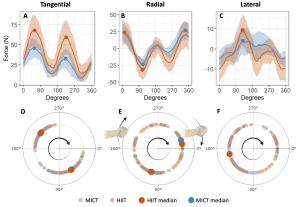Kellie Halloran, the labs’ first multi-year-undergrad-researcher turned grad student, recently deposited her MS thesis entitled “Propulsion kinetics of recumbent hand cycling during high and moderate intensity exercise”. Kellie is continuing on in the lab to pursue a PhD. The abstract from her thesis is below, along with one of the amazing figures in the document.
People with spinal cord injuries (PwSCI) are at high risk of developing cardiovascular disease (CVD). While regular exercise can reduce risk of CVD, PwSCI face various barrier to exercise, including high rates of upper limb soft tissue injuries, especially in the shoulder. Handcycling high intensity interval training (HIIT), which consists of periods of high intensity exercise followed by rest, is a potential exercise solution, but the musculoskeletal safety of HIIT is still unknown. In this study, we characterized three-dimensional continuous applied forces at the handle during handcycling HIIT and moderate intensity continuous training (MICT). These applied shoulder forces can give an early indication of joint loading, and therefore injury risk, at the shoulder. In all three directions (tangential, radial, and lateral), the maximum applied forces during HIIT were larger than those found in MICT at all timepoints, which may indicate higher contact forces and loads on the shoulder during HIIT compared to MICT. The tangential and radial forces peaked twice in a propulsion cycle, while the lateral forces peaked once. Throughout the exercise protocols, the location of tangential peak 2 and radial peak 1 was later in HIIT compared to MICT. This difference in maximum force location could indicate altered kinematics at the end of the exercise protocol. These changes in kinematics should be more closely examined using motion capture or other modeling techniques. If we combine this kinetic data with kinematic data during propulsion, we can begin to create musculoskeletal models that more accurately predict contact forces and injury risk during handcycling HIIT in PwSCI.


